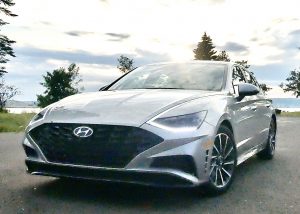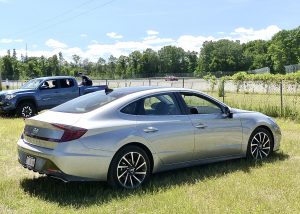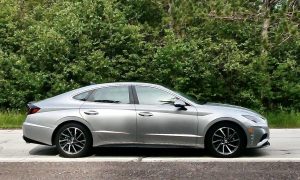2020 Sonata: Sexy look, comfort, and 47 mpg!
By John Gilbert
As someone who has been test-driving and reporting on new vehicles for something like 50 years, I have established a few techniques to prove my own objectivity to myself. And there’s always room for new tricks, which I learned by driving the totally redesigned and seductive 2020 Hyundai Sonata.
The precise moment when Hyundai lifted the South Korean auto industry from mediocrity to elite status was when the 2011 Sonata was introduced. It had been a mediocre midsize car with a great warranty, but, inspired by a stinging rejection of its new engine by prospective partners Chrysler and Mitsubishi, Hyundai went back to a clean sheet and focused on building an all new 2.4-liter 4 cylinder.
The engine was to be housed in a dramatically restyled car, and both partners were surprised how quickly Hyundai built such an impressive engine from scratch. Both Chrysler and Mitsubishi still use variations of that 2.4 engine in some of their vehicles.. For its own Sonata, Hyundai engineers also designed an intricate but impressive direct fuel-injection system, and, while they were at it, designed and built a lighter and more efficient 6- speed automatic transmission.
The total package, from exterior design to engine, transmission and suspension, put the car and the company on an entirely new plateau, from which it has never looked back from that 2011 model year breakthrough. Since then, Hyundai has developed and improved its array of impressive SUVs, compacts and even luxury cars, transforming its new-found technology through its entire engine line.
But the Sonata remains the heart and soul of the company. Which brings us to the 2020 Sonata, a car that is another complete surprise.
As the world turns to SUVs, Hyundai seems to believe SUV buyers may turn back to sedans, once their SUV is parked in the driveway. And without question, the 2020 Sonata could turn a lot of heads and desires back to the sedan world.
The first time I saw one, it was from the rear corner and I thought it was a new Mercedes 5-door-coupe model. Then I walked around to the front and was surprised to see the stylized Hyundai “H” badge on the grille.
It took a while, but we finally got to spend a week with a 2020 Hyundai Sonata Limited a few weeks ago, and we enjoyed its looks and its agility and surprising power on the hills of Duluth, Minnesota. And when the idea hit us, we decided to drive the Sonata from Duluth over to Central Minnesota to watch the Trans-Am road race at Brainerd International Raceway, and drive back after the race. On that trip, the Sonata provoked a previously never-done move by me.
Often, when I think I haven’t given a car a fair test of highway driving, I’ll zero the odometer and get a fresh, highway-only calculation.
But the trip odometer on the Sonata had shown a figure I thought was absurdly high, so for the first time, I zeroed it to bring it back to reality. After all, it had the exceptional but small 1.6-liter Turbo engine, and the Sonata is a big, Accord-Camry-Mazda6-sized car to haul around. My mistake. After zeroing it, we drove east along Hwy. 210 and my wife, Joan, took a long turn behind the wheel. That let me relax in the passenger bucket and examine all the features of the redesigned dash, with its long, horizontal information screen in the middle of the dash. My newly reset trip-odometer now read: 46.7 miles per gallon!
I guess my earlier assumption was not just wrong, but I reset it twice to recalculate, and our highest figure attained was 47.1 mpg. Astonishing! That’s hybrid, or diesel, territory, and many of them can’t get that much.

Neat gauge-work transposes rear-facing video to replace either the tach, for left, or speedometer, for right turns,. Note the 44.1 mpg, too.
There were other neat things to notice. For one, the instrument cluster has a large tachometer on the left and an equally large speedometer on the right, and you can switch to all sorts of other information to be injected within them. But one surprise is something Hyundai borrowed from its exceptional Palisade SUV. When you hit the left turn signal, the tach is replaced by a rear-facing video of all there is to see behind you on your left; turn right and the speedometer disappears for a moment to show you any oncoming vehicles on your right. It’s also handy when you’re maneuvering in your own driveway, just to bolster the rear-view camera view that shows both what’s behind you and a 360-degree top-down video of all surroundings.
When we had to give the Sonata back for its return to the press fleet in Chicago, we were sorry to see it go. A few weeks later, I asked wife and co-driver Joan where she thought the Sonata fit in among the doses of fantastic vehicles we had test-driven in the past year.
Without hesitation, she said she would rank it among the best, just because it looked so sleek and stylish, and because it was extremely comfortable, and it also was surprisingly peppy to match its agility.
When I reminded Joan about coming down the big hill into West Duluth after our trip and watched the Sonata fuel computer hit a high of 47.1 miles per gallon, she said: “Oh yeah. That too.”
The fuel economy might have been the single more amazing feature of the new Sonata, but there are so many things to be impressed by, it had completely slipped her mind. I understood, because the low and seductive look of the Sonata looked even more dramatic amid the sea of large pickups and SUVs we found in traffic and parking lots everywhere.
Vastly upgraded materials, fit and finish of the new interior, with a master-control array of switches on the console, and the long horizontal navigation screen is cut into a quite-elegant and simple padded upper dashboard. You can adjust the driving mode for optimum comfort, and while we found it comfortable, after our trip we realized we were in “Sport” mode rather than economy or c,omfort but the car was so smooth and comfortable we didn’t think of adjusting.
Hyundai has revised its excellent 6-speed automatic transmission, which is now an 8-speed that is smooth as silk shifting. Hyundai also has given in to those who enjoy driving by installing steering wheel paddles to allow manual up and down shifting of that dual-clutch automatic.

A line of LED lights outline the headlights and fade as they follow the seam of the hood, further enhancing the new look.
All of the recently developed features and safety elements also were included on the Limited, including a surprising switch from the previous Harmon Kardon audio system to Bose. The audio system in the car was always a strong point, and I would have to say the Sonata has gone from excellent to still-excellent, maybe with better separation.
Hyundai was at the leading edge when blind-spot and lane departure alerts came into vogue, and I considered Hyundai ahead of the pack because its lane-centering control could actually keep your car or SUV in its proper lane, and in the center of that lane. The Sonata has that.
The test car was just an eyelash under $30,000, which is a considerable bargain for all that’s offered. It starts at a base price around $25,000. That balance and coordination of all its assets is nothing short of outstanding, especially in a car that looks so sporty and slick.
Also, instead of mundane daytime running lights, a sharp line veers in from the headlight pods and rises in a thin line along the seam between the hood and front fenders. Look closely and you see that there is a little LED strip that fades as it runs toward the windshield.
Such features are not necessary, or in great demand, presumably, but in the hotly contested marketplace, little things that make you feel your purchase is special, could be a deal-maker.
The base engine in the Sonata is a newly enlarged 2.5-liter 4 with 191 horsepower and 181 foot-pounds of torque. The upgrade is the smaller 1.6 Turbo, with 180 horsepower but with 195 foot-pounds of torque. In the process of focusing on more-mainstream consumer cars and letting affiliate Kia go after the performance-minded, Hyundai is not ignoring the hot-rodders. It has come out with an entire line of higher-performance vehicles, designated by a simple “N.” And the Sonata will add turbocharging to the 2.5, plus all sorts of aero touches to create a Sonata N-Line — it will have 290 horses and 310 foot-pounds of torque.
Me? I would stick with the1.6 Turbo version. Let the N-Line buyers drag-race each other, I’ll take an extra second to reach 60, while I keep resetting the trip computer to see if I can top 47 miles per gallon.





 John Gilbert is a lifetime Minnesotan and career journalist, specializing in cars and sports during and since spending 30 years at the Minneapolis Tribune, now the Star Tribune. More recently, he has continued translating the high-tech world of autos and sharing his passionate insights as a freelance writer/photographer/broadcaster. A member of the prestigious North American Car and Truck of the Year jury since 1993. John can be heard Monday-Friday from 9-11am on 610 KDAL(www.kdal610.com) on the "John Gilbert Show," and writes a column in the Duluth Reader.
John Gilbert is a lifetime Minnesotan and career journalist, specializing in cars and sports during and since spending 30 years at the Minneapolis Tribune, now the Star Tribune. More recently, he has continued translating the high-tech world of autos and sharing his passionate insights as a freelance writer/photographer/broadcaster. A member of the prestigious North American Car and Truck of the Year jury since 1993. John can be heard Monday-Friday from 9-11am on 610 KDAL(www.kdal610.com) on the "John Gilbert Show," and writes a column in the Duluth Reader.